When the Catholic Church declares an individual a “saint,” a date on the liturgical calendar is assigned to them, providing a day each year to celebrate their life.
As a general rule, this day is almost always their date of death. Since saints are believed to already be in Heaven, the date of a saint’s death would be considered their “heavenly birthday,” or “entrance into Heaven.”
This is why you can almost always know the date of a saint’s death. Odds are likely that they died on the day the Church venerates them in the liturgy.
However, this is not always the case.
First of all, there are 3 birthdays celebrated in the Church’s calendar. These are the birth of Mary (September 8), the birth of Jesus (December 25) and the birth of St. John the Baptist (June 24).
Secondly, sometimes the Church will postpone the celebration of a saint, due to their date of death falling in the midst of Lent. During the season of Lent it is more difficult to celebrate the life of a saint, as it is a penitential season and the Lenten liturgy supersedes most feast days.
An example of this is the feast of St. John Paul II. He died on April 2, 2005, which would fall during Lent or the first week of Easter. As a result, the Church assigned October 22 to be his feast, which is the anniversary of his elevation to the papacy.
On other occasions, the saint’s date of death coincides with the feast day of another saint who would receive precedence in the liturgy. If the Church wants everyone to honor a specific saint, but can’t because of a different saint already on that date, the Church may look for the next unoccupied space in the calendar.
This is the case for St. Thérèseof Lisieux. She died on September 30, but that is the feast of St. Jerome. Originally the first open spot in the calendar was October 3, and that was her feast for many years. However, after the liturgical calendar was reordered in 1970, the date of October 1 opened up and she was given that day.
Above all things, the Church holds-up these men and women for our example and points to them to inspire us to be saints. We honor them as our ancestors in the faith, those who “ran the race” and were victorious.



